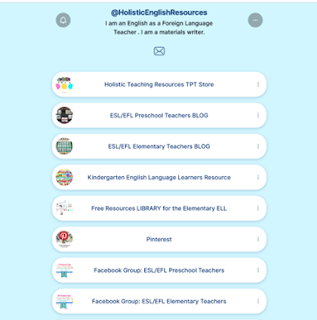Link to the Adjectives ESL resource is here for your lesson planning :
https://www.teacherspayteachers.com/Product/Adjectives-for-Elementary-ELL-2150071
Improve
listening skills with this flashcard activity. Show students
the flashcards with adjectives of size: big, small.
Describe
a flashcard only using an adjective. The children point to it and guess which
one is it.
Teacher: long and big.
Students: purple
dress.
Adjectives
of size with big and small backpacks.Teacher: What is
this?Student: It is a
backpack.Teacher: It is a
big backpack. And this?Student: It is a
small backpack.
Play
beanbag game with the adjectives of size: tall and short. Adjectives
naturally lead into learning how to build longer and more complete sentences.
Make
2 beanbags. Place all the flashcards on the floor in random order and have
students take turns throwing the 2 beanbags to the opposite adjectives.
Teacher: He is a tall man!
Place
this adjective flashcard on the board for talking about
physical appearance.
Ask
questions to develop the oral and listening skills.
Teacher: Look at
this man. He is tall. (write the word tall
in white)
Look at this man. He
is short. (write the word short in white)
Do
the same with thin and fat but with a yellow chalk. Assign a name to each man.
Make sentences.
Teacher: Pedro is
tall and thin. Eddy is fat and short.
Have
the class pick two students to make more sentences similar to the example.
Adjectives flashcards of quality or condition: Dirty and clean.
Teacher: What are
these?
Student: They are
pants.
Teacher: They are
clean pants.
Teacher: They are
dirty pants. Point to the dirt spots.
Introduce
the adjectives of condition new and old with the flashcards. Show
students the difference that these words are used for things. Point to the
first car.
Teacher:
What is this?
Student:
It is a car.
Teacher:
It is a new car.
Teacher:
What is this?
Student:
It is orange.
For
Food. Adjectives of temperature: Hot and cold.
Adjectives of Taste (Sensory Adjectives)
Adjectives
of emotions or mood. Here
we have happy and sad flashcards.
Student:
He is Danny.
Teacher:
Danny is happy.
Teacher:
Who is this?
Student:
He is Joe.
Teacher:
Joe is sad.
Have
two students come to the front and act as a happy and sad. The class has to
make more sentences.
Adjectives
of Age. These describe how old or new someone
or something is, in terms of time, age, or development.
Descriptive
Adjectives – Appearance (specifically Hair Adjectives)
These
are a subcategory of physical appearance adjectives and describe: Color, Length,
Texture, Style.
Descriptive
Adjectives – Personality & Appearance
They
are often divided into two related subcategories: Appearance Adjectives and
Personality/Intelligence Adjectives
Adjectives
of Wealth or Socioeconomic Status. These
adjectives describe a person’s or group’s economic condition, specifically how
much money or material resources they have.
Adjectives
of Quantity (or Number)
These
adjectives describe how much or how many of something there is. They're
especially useful for countable nouns and are often taught early in English
language learning.
Adjectives
of Strength or Physical Ability. These
adjectives describe how much power, energy, or physical ability someone or
something has.
Directional
words or spatial words.
Up
and down. Adjectives help students describe
making their language more specific and expressive.
Activity
1. Have your students stand up and sit down as you show the flashcards or
arrow cutouts.
Activity
2. You can also give instructions using their hands.
Teacher: Hands up !
Teacher: Hands down
!
Teacher: Boys, Hands
up. Girls, Hands down.
Then introduce left
and right.
Teacher: Hands to
the right!
Teacher: Hands to
the left!
Descriptive
adjectives related to weather conditions.
These adjectives describe what the weather is like.
Adjectives
of physical state or need. They describe how
someone feels physically—specifically, related to basic needs like food and
drink.
Adjectives
of Age or Time Period.
There are more adjectives flashcards to this resource. Download and use according to your lesson plan.
This resource has more to check, go to this blog post:
https://eflelementaryresources.blogspot.com/2025/06/adjectives-craft-stick-puppets-sorting.html

Explore the links to my social media and blogs. Get ready to bring excitement to your classroom:
linktr.ee/HolisticEnglishResources





























































